Key (lock)
![]()
The title of this article is ambiguous. For other meanings, see Key (disambiguation).
A key is a tool for locking and opening a lock, e.g. a door lock or padlock. For this purpose, the key is usually inserted into the lock through the keyhole and the lock is opened by turning it. Keys are used for burglary protection and access control.
Each key has a specific code. This locking code or key coding refers to the arrangement and combination of holes or teeth (serrations) on the key bit. This allows the key to be assigned to one or more identical cylinders that correspond to this coding.
Historically, the most common form of key is the cunt key. Its handle is called a Räute, Räude, Reite or Reide. This could be richly decorated in earlier times. The part grasping the locking device, which ideally only fits a particular lock, is called the bit. It is hard soldered to the stalk, cast with it or forged. The shank can be solid (solid shank) or hollow (hollow shank). In order to limit the insertion depth of the key, sometimes a thickening is attached to the neck (die, boss). All this is to ensure that the lock in question can only be opened with this or an identical key. After all, the purpose of a lock and key system is to protect a room, a vehicle or other objects from unauthorized entry, use or other access.
Keys were initially made of wood, later - as today almost exclusively - of metal. They are usually connected with a key ring and often several keys thus form one/one key ring. Keys intended for use by several authorised persons are often kept in a key box.
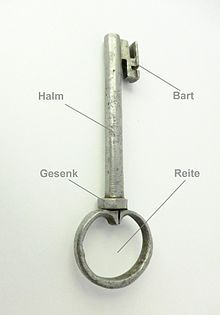
Components of a historical door key

Miscellaneous keys
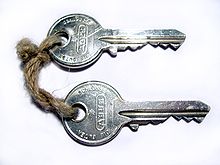
Two identical keys
Lock and key history
The historical origin of individual locking systems is described in the article Lock (technology). In the following section, however, the overall development is dealt with chronologically.
prehistory and early history
From the late Bronze Age, for example, prehistoric soil finds of 30-50 cm long bronze keys in the form of sickle-shaped hooks have been made in the pile-dwelling settlements of the Alpine region. They consist of two parts: the handle, which often has a ring end, and the long hook-shaped shaft, which is bent inwards again shortly before the end. The handle is sometimes twisted or decorated with plastic cross ribs. Particularly elaborately crafted keys also feature ducklings or stylized waterfowl. Often, however, the handles are missing altogether, as they were made of organic material. These Bronze Age keys were used to operate simple wooden locks: The bolt on the inside of the door was pushed to the side through a hole in the door.
Of similar shape, but made of iron, are the keys of the Celts from the Hallstatt and Latène periods. Later examples have multi-pronged hook shapes.
Ancient
Egyptian keys
In Egypt, locking techniques that could be operated from the outside with the aid of a push key were already known in the New Kingdom, and there are several material and literary references to them.
Greek keys
In ancient Greece, keys probably appeared in Homeric times, and are also described in the Iliad and Odyssey.
Greek keys are of two different types: the temple key, the oldest type, in use since about 1000 BC, and the laconic key, in use since the 5th century BC.
The temple key is made of bronze, is about 40-50 cm long and was worn on the shoulder due to its size. It has been preserved materially as well as in inscriptions and was an attribute of priests and priestesses, for whom the temple keys were a symbol of dignity and power. The handle of the temple keys is worked and was usually originally lined with wood or ivory. There are few preserved examples of the Greek temple key, the corresponding locks made of wood no longer exist, but could be reconstructed. In this lock, the key is inserted through a round, metal-framed keyhole and the bolt is pushed aside with a deliberate sideways thrust. The end of the key was often made wider so that it hit the stop better. To close the lock again, the bolt was pushed back into place with a strap.
In the post-Homeric period, the key was perfected and the laconic key was invented. The associated locks had a better thought-out locking device and thus offered greater security. The laconic key was forged from iron. It has a straight shank with a right-angled bent bit with three or four teeth. These lift up corresponding locking blocks (βάλανοι/balanoi) in the wooden lock mechanism, hence the name balanos lock. The handle end is often forged out in a ring shape. In the associated lock, a wooden bolt was brought into the closed position from the outside by a strap and then artfully knotted. In order to open the gate, the strap had to be unknotted so that the bolt, which was notched or bumped, could then be pushed back by the laconic key. The laconic key is with 10-14 cm much shorter than the temple key. It is the model for Celtic and Roman keys.
Celtic keys
In the Hallstatt period the keys were made of wrought iron and served as burial objects. In their shape and size they resembled Bronze Age keys. They are quite long with 25-40 cm.
The keys of the Latène period are also made of wrought iron. The end of the handle is forged in a ring shape, occasionally a die is also found. The beard has the shape of a hook-shaped point and three or more teeth. There are also T- or anchor-shaped beards. With 6-30 cm they are shorter than the keys of the Hallstatt period.
Apart from the division into Hallstatt and Latène period keys, Celtic keys are also further subdivided according to appearance and function. Hook-shaped, s-shaped and laconic keys are considered to be simple key forms. In addition, there are keys to spring locks. This key-lock principle consists of the square spring or eye pin, which functions as a locking key, and the key with a frame-shaped forged bit. The locking key is inserted through a narrow slot. The spring-loaded wings of the lock are pressed together and snap back into place after the key has passed through the opening. The locking key can then no longer be withdrawn, but only released by the frame-shaped key, whose bit presses the springs back into place.
Also important are the Sanzeno keys, named after the place where they were found. Due to their size (35-52 cm) and their characteristic beards, they occupy a special position among the Celtic keys. About 50 bronze or iron keys are known. The handle of the keys is shaped differently, there is a kind of early form of the swage, the beard shows bizarre forms. The Sanzeno keys are probably an early form of the lifting-pushing key. Here the key is inserted into the lock through an L-shaped keyhole. The tines of the bit grip the wooden latch attached to the inside of the door from below, lift it up and push it to the side.
Roman keys
In the archaic era there are no known keys, but it is assumed that keys existed here as well. Also with the Etruscans there are hardly any keys, these became really known only with the conquest by the Romans.
In the Roman Republic, the laconic key was used according to the Greek model. This was used, for example, to lock house doors. Chests were tied up with straps and sealed. The seals were worn here on the middle finger of the left hand and were called finger keys.
Roman locking technology only developed decisively during the imperial period, i.e. from around the turn of the century around the birth of Christ. The wooden bolts were increasingly replaced by metal constructions. The so-called lifting-sliding keys for this purpose can be recognized by their angled beard, which is perpendicular to the handle. Countless examples have survived as archaeological finds (over 200 have been found in Fort Saalburg). Their size and frequency suggest that not only doors, but also furniture and boxes were locked in this way. The width of some small keys made it possible to carry them on one's finger like a ring. The Romans also used revolving keys, whose locks were technically more complex. Larger keys were forged from iron, the smaller ones were cast from bronze, even those with a handle of bronze and a beard of wrought iron are known. The keys were made in moulds, the beard got its shape by subsequent grinding or sawing. If the key was made of bronze and iron, the beard was cast on using the lost wax process. Roman keys are between 2 and 25 cm long and have simple to very elaborately designed handles, for example in the shape of animals. The beard has different numbers of teeth and can be openwork.
Key from Israel
An important form of the key in Israel was the elbow key of the 2nd century B.C. This is a kind of lifting-pushing key. The shaft is not straight, but bent at right angles, and thus consists of the upper and lower arm. It has 5 teeth, is made of iron and in the case of large keys has a spherical handle made of wood. In the case of the corresponding lock, the bolt cannot be moved after it has been closed, as it is held shut by a tumbler consisting of prongs which are pressed into holes in the bolt by one or more springs. The key is then inserted into the keyhole from the outside, the forearm grips the bolt, the bit lifts the tumbler and the bolt can be pulled out, with the entire key serving as a handle.
Medieval
Anglo-Saxon keys (6th-11th century)
The Anglo-Saxon keys are mainly known as grave goods for the journey to the afterlife. However, there are only a few key finds and thus only little information. The keys are made of bronze, have an eyelet, a simple beard and were probably worn on a chain around the neck.
Viking key (8-11th century)
There are numerous finds of Viking keys. They are characterised by a simple openwork beard, a short shaft and a large, ornamental or animal-figured flagon. Also common are highly stylized dragon patterns, braided patterns, anthropomorphic figures. Viking keys were made of bronze. They were not only an object of daily use, but also an amulet and were worn on the body.
Early medieval and Carolingian keys
From the early Middle Ages only very few keys are preserved, the knowledge about them is therefore very sparse. They are made of bronze, are rather small (6-13 cm) and have a richly pierced flagon. Rare are also lantern-shaped, decorative keys, often representing a building or part of a building. The beard is very simple and often has the shape of a bird of prey's head. These are rotary keys with ring and hallmark decoration.
Romanesque keys
Romanesque keys are also very rare. Like the early medieval keys, they are made of bronze, are rather small (4-12 cm) and have a round flute. From the 12th century onwards, wrought-iron, significantly larger keys with geometrically shaped flutes predominate. The conspicuously long shaft tip protrudes far beyond the bit, thus facilitating penetration into blocked keyholes. From the middle of the 12th century, keys were up to 30 cm long, with cross-shaped patterns on the reid. Early Romanesque beards are small and simple, often becoming large later. Sometimes they are pierced with geometric patterns. As in the entire Middle Ages, they are turning keys.
Gothic keys
In the Gothic period, Gothic ornaments with arch, pass and leaf shapes became obligatory forms of the keys. A characteristic feature is the diamond shape of the flute, the ends of which were often forged enlarged. In addition, the keys often have knobs and, following the window rosettes, rosettes. In the early Gothic period the keys were still made of bronze, 3-12 cm long and had a simple beard. In the High and Late Gothic periods, the keys were made of wrought iron and were up to 50 cm long. The beard developed into a delicate comb beard, which was often richly pierced with crosses and rectangles. In addition, in the Bamberg legal document of 1329, the making of keys was made a punishable offence for the first time. The Regensburg guild regulations of 1393 also stipulated that the beards of the keys had to be so well adapted that it was impossible to open the locks with a different key.
Modern Times
Renaissance key (15th-16th century)
In the Renaissance, the emerging steel-cutting technique made it possible for the first time to sculpt figures from a forged piece of metal, which extremely expanded the possibilities of decoration. Generally, Renaissance keys are 4-30 cm long, are turning keys and have beards with fine incisions. In addition, the beards are star-shaped, cross-shaped or meandering openwork. Different styles developed in the different regions of Europe. In Germany, Switzerland and Austria, keys with rolled ornamentation were typical, forming a handle of double spirals. In Italy and France, on the other hand, keys were decorated with grotesques, acanthus tendrils, chimeras, dolphins or mythical creatures of the sea. The key chalk thus became an elaborate composition, and the die was given the form of an antique capital. Particularly noteworthy are the Venetian keys. They have a round or oval chalk, which is decorated with soldered ornaments in the form of rosettes, making it resemble Gothic windows. The handle has an eye or crown, and the shank is usually hollow. The beard is simple or has intricate cross-shaped incisions.
Lantern handle key (16th-18th century)
In the 16th century, the art of key and lock making reached its peak with the production of lantern handle keys. Especially the keys made in France are true gems of the blacksmith's art. In order to be accepted into the guild as a master craftsman at this time, the journeyman had to produce a lock with a matching key as a masterpiece, resulting in the production of true works of art. In addition, the resulting keys are usually signed and dated. The key chalk of the lantern handle keys was stylized into a tower-like structure resembling a lantern or a basket. This structure rests on a finely openwork rosette, which forms the centre of the key. The outside is often decorated with masks or rings. The rosette rests on a richly openworked square or rectangular base, which formed the die. This is followed by a short hollow shaft with a fine comb beard, which can have up to 28 teeth. At the beginning of the production of lantern handle wrenches the beard was flat, later it was hatchet-shaped. The fine finish was made possible by fine drilling and cutting techniques, as well as steel turning. Despite the fineness of the keys, they were strong enough to set the lock mechanism in motion.
17th-18th century
Finally, in the 17th century, heavy hand-forged iron chests appeared as safes for merchants, nobles and guilds for money, jewellery and valuable documents with matching large-calibre keys. These chests often have a lock centrally located in the lid. To open it, a simple turning movement sets in motion a complicated mechanism which operates up to 25 latches. On the front of the chest there was also a keyhole as a dummy, while the real one was camouflaged in the lid of the chest. The keys matching the chests are well-shaped with distinctive recesses on the beard, often cross- or star-shaped.
In England, another new type of key appeared in the 17th-18th centuries. The newly emerged steel-cutting technique made it possible to decorate to a previously unknown degree. This made it possible to produce keys with heavily openworked, finely chased flutes and an exuberantly ornamented collar, shank and beard. This resulted in light but solid keys, for example for cabinets, chests of drawers, secretaries and jewellery boxes. English keys were in great demand in England and on the Continent, so they were exported in large quantities.
Rococo key
In the Rococo period, the fashion for writing letters led to an impoverishment of the key. The production of magnificent desks and secretaries with their rich ornamentation displaced the keys. Instead of richly decorated keys made of wrought iron, simple keys made of bronze now appeared. These are distinguished above all by their asymmetrical flute, which is decorated with tail patterns, foliage or C rocailles. The handles of the keys are of simple form, the die is always spherical. The keys of the Rococo are turning keys of 5-25 cm length.
18th-19th century
The 18th and 19th centuries were the last period of the hand-forged key. Due to the industrial revolution and the multitude of new lock designs from America, which promised more security, only a few elaborate keys were still made by hand. The guild craft was replaced by the manufactory, where keys were mass-produced. In the second half of the 19th century, lock factories were also founded in which the work process was divided into individual operations and machines could be used. Around 1870, numerous new lock factories, key foundries and supplier companies were founded. An important innovation was, for example, the malleable casting process, in which the brittle cast iron was transformed into forgeable iron by means of long-lasting heat treatment (annealing at 800-900 °C for several days). In addition, several keys could be cast and then machined at the same time. This process was much cheaper and thus displaced the hand-forged key.
Especially between 1770 and 1851 many innovations appeared, so in this period about 70 models of different locks and keys were patented. One of the first patented locks was that of Robert Barron. The lock featured two tumblers, moving parts in the lock case that released the bolt when the key was turned. Another pioneer was Jeremiah Chubb, who invented the multi-tumbler lock with six tumblers. With this lock, there were already over 100,000 ways to move the tumblers aside. In addition, a detector mechanism blocked the tumblers when a lock pick was used.
There was also a real competition between inventors and lock pickers. Whoever succeeded in picking a lock that was considered secure under supervision was expected to win high cash prizes. A. C. Hobbs caused a sensation in 1851 when he announced that he was able to open the Chubb lock, which was considered top secure and was even known to the British government as impossible to pick, within 30 minutes. He was able to prove this to a special committee: He opened the lock within 15 min and locked it again in another 7 min. He then tried his hand at the Bramah lock, which was considered unpickable. He was given 30 days by the committee to do this, but he only needed 10 of them to pick the lock. His method became known and publicized as Hobb's pick method. Many burglars saw this as valuable advice, which they put into practice.
Of the numerous inventions made during this period, however, only Linus Yale's lock, which he had invented in 1844, prevailed. The key and lock differed considerably from earlier designs and were also suitable for industrial production. The Yale cylinder lock initially attracted little attention at the Great Exhibition in London in 1851, and it was only after Yale's son Linus Yale Junior improved the lock in 1864 that it achieved a breakthrough. In the Yale cylinder lock, the locking and bolt construction are separate. The key sets the cylinder in motion, which in turn sets the bolt in motion. This made it possible to keep the key very small and flat, and resulted in a large number of possible locking variations. With older key-lock mechanisms, the bolt was always moved directly by the key.
Precision mechanics was joined by microelectronics, which plays an important role in the Kaba Nova key, for example. This key functions through an interplay of mechanics and microelectronics. The microelectronics with stored access codes are housed in the slide, followed by the contact field in the die, which establishes the connection to the electronics integrated in the door. The beard of the Kaba Nova also has a flat beard with extremely precise drilling and milling. This results in over 25 trillion locking combinations.

Roman key made of bronze, approx. 6.6 cm long

Romanesque key
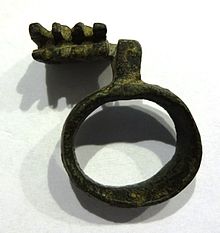
Roman bronze key ring
Today's keys: special forms and variants
Master key
Several different locks can be unlocked with a master key. It is also referred to as a master key, central key or passepartout (from French passer 'to pass through' and partout 'everywhere'). The authorised user of a key holds the key power.
New construction key
A new construction key is a tool that can be used to open doors without hardware or a latch.
Impact wrench
· 
Impact wrench
·
Drill recess wrench
The adjacent picture shows so-called impact keys. The profile notches are all uniform at the deepest point. With such keys and a special impact technique you can open most lock cylinders. Locksmiths usually have such special keys in their toolbox.
Mechanical keys
There are bunt-bit and cylinder lock keys. Safe locks can sometimes only be unlocked by the introduction of two or more keys, each held by different people. This means that no user is alone when opening the door.
Furthermore, there are drill recess keys or reversible keys. Here, the blank is drilled to different depths on the sides, the drilling pattern is identical on both sides - the key closes no matter how it is inserted into the cylinder.
Cross-bit keys are also used for apartment doors, showcases, cabinets and the like. There are installation locks for converting mortise locks with bunt-bit keys to cross-bit keys with six coding pins.
·
Car key/Ford
·
Tibbe Key Code
Special car keys
Car keys (ignition keys) often look similar to the serrated beard keys and are usually symmetrical in shape. There are also special key shapes, such as those from Ford according to the Tibbe code. Renault keys have a small hole in the front of the bit. Car keys can also have angular grooves in the sides.
Berlin key/plug-through key
The Berlin key or pass-through key is a key with two beards. It is used to force house residents to lock up again after entering or leaving the house. You first have to unlock the house normally and then push the key through the keyhole. After locking from the inside, the key can be removed again. The system was invented in 1912 by the Berlin key maker Johann Schweiger. The Berlin key was widespread in the first half of the 20th century, but it is hardly used today.
Electronic keys
In addition to mechanical keys, there are also magnetic card keys or electronic or electromagnetic systems, for example:
- with wireless transmitter (like car key),
- with fingerprint recognition or
- with RFID technology. These are also referred to as transponders. These transponders are available as a card or key fob or integrated into a mechanical key, as is now common for car keys with an integrated immobiliser.

Active transponder in combination with a mechanical key
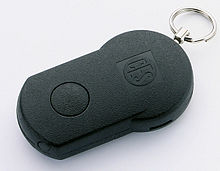
Active transponder
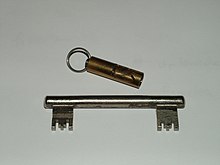
Berlin key with holder
Search within the encyclopedia


